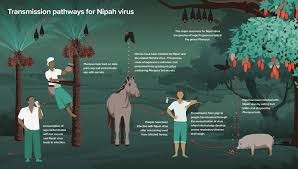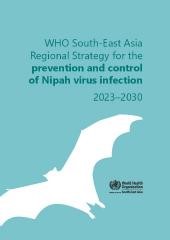WHO considers Nipah Virus infections and related henipaviruses a priority group of viruses, because of their broad geographical range, the wide range of animal species they can infect, a propensity to regularly spill over to human populations, a high case fatality rate from infection and non-availability of specific licensed drugs or vaccines.

Transmission pathways of Nipah Virus (Photo- EcoHealth Alliance, USA, 2023)
Since 2001, Nipah virus has caused outbreaks of severe illness and death in Bangladesh and India. Countries of the Region are at risk wherever there are susceptible animals, the presence of the virus, and a pathway for transmission. Accordingly, in the aftermath of the 2018 outbreak in Kerala, India, and in light of the emerging public health risks for Nipah virus infections, WHO accorded the highest priority to Nipah Virus infection as a regional health security threat.
Under the guidance of the Regional Director, World Health Emergencies organized, an expert consultation on Nipah virus infections in October 2019. Following the recommendations of the expert group, “WHO South-east Asia Regional Strategy for the prevention and control of Nipah virus infection, 2023-2030” was developed and released at the Regional Committee meeting in November 2023.

WHO South-East Asia Regional Strategy for the prevention and control of Nipah virus infection 2023–2030 ( Photo -WHO, SEARO)
The Regional publication provides guidance to Member States of the WHO South-East Asia Region to prevent severe illness and deaths from Nipah virus infections. This document considers and incorporates the best evidence from scientific research and practical field experiences from previous outbreak investigations, and describes key components of the Regional Strategy, priority activities for each component, milestones, and timelines based on whether countries have reported human cases or not.
A section on monitoring and evaluation describes indicators to assess progress for the Region towards achieving the Strategy. Using a ‘One Health’ approach, the document will be helpful for programme managers in MS to develop strategies for the prevention and control of other high-threat pathogens.
